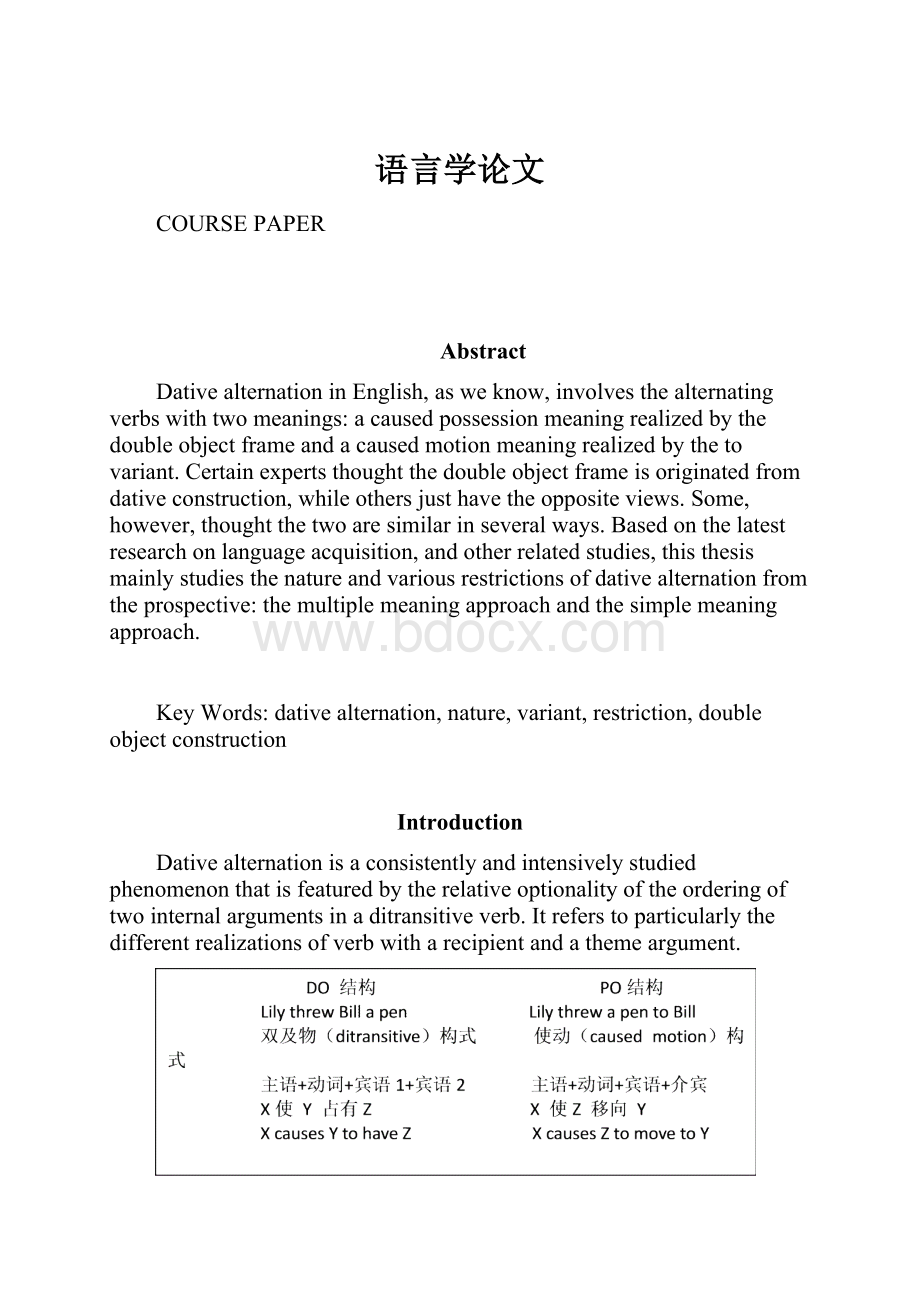语言学论文.docx
《语言学论文.docx》由会员分享,可在线阅读,更多相关《语言学论文.docx(9页珍藏版)》请在冰豆网上搜索。

语言学论文
COURSEPAPER
Abstract
DativealternationinEnglish,asweknow,involvesthealternatingverbswithtwomeanings:
acausedpossessionmeaningrealizedbythedoubleobjectframeandacausedmotionmeaningrealizedbythetovariant.Certainexpertsthoughtthedoubleobjectframeisoriginatedfromdativeconstruction,whileothersjusthavetheoppositeviews.Some,however,thoughtthetwoaresimilarinseveralways.Basedonthelatestresearchonlanguageacquisition,andotherrelatedstudies,thisthesismainlystudiesthenatureandvariousrestrictionsofdativealternationfromtheprospective:
themultiplemeaningapproachandthesimplemeaningapproach.
KeyWords:
dativealternation,nature,variant,restriction,doubleobjectconstruction
Introduction
Dativealternationisaconsistentlyandintensivelystudiedphenomenonthatisfeaturedbytherelativeoptionalityoftheorderingoftwointernalargumentsinaditransitiveverb.Itreferstoparticularlythedifferentrealizationsofverbwitharecipientandathemeargument.
AnyanalysisofthedativealternationinEnglishneedstomentionthequestionsbeinghotlydiscussedofthesedaysofwhatactuallyleadtothealternation.Thealternationincludesverbsthatillustratetworealizationsofthesamearguments.Verbsdenotingakindoftransfermayoccurintwodifferentconstructions. AswhatareexampledinthefollowingsentencesTheDativeAlternationinvolvesthevariationbetweenthedoubleobject(DO)constructionandtheprepositionalobject(PO)construction
Differentconstructionsendowsentencesofthesameoriginwithdistinctemphasisandfordifferentpragmaticuses.
AnalysisofNatureBasedontheTwoResearchApproaches
Therearetwomainwaystoanalyzethedativealternation:
Thesinglemeaningresearchaswellasthemultiplemeaningresearch.Thefirstoneisthatbothvariantsarerelatedtothesamemeaningwithwhichtwoargumentrealizationoptionsareallowed.Thesecondoneisthatvariantsareassociatedwithalittlebitdifferentbutrelatedmeanings,witheachmeaningleadingtodistinctargumentrealizationpatterns.Thefirstoneisdefinedasthesinglemeaningapproachandthesecondmultiplemeaningapproach1.Andnowadays,inthelinguisticfield,thesecondmultiplemeaningapproachdominates.Itindicatesthenon-derivationalrelationbetweenvariants:
eachoneisconnectedwithitsownmeaning,thoughthesearenotalwaysdistinguishableunderatruthconditionandeachleadstoitsownargumentrealization2
Onmostinstantiationsoftheapproach,theto-variantexpressescausedmotion.UsingGoldberg’s(1995)characterization:
anagentcausesathemetomovealongapathtoagoal,wherethemovementandpathareinterpretedinthepossessionalfieldThedoubleobjectconstructionillustratesthecausepossession:
tocauseareceivertopossessanentitywithabroadlyconstructeddefinition3.
ManydativeverbssuchasgivecategorizeeitherforanNPdirectobjectandaPPindirectobject(b),whichcanbereferredastheprepositionalstructure.
a.LilygaveBillaticket.(DO)
NP1VNP2NP3
b.LilygaveatickettoBill.(PO)
NP1VNP3toNP2
Sentenceaandbcanbeinterpretedrespectivelyas:
a.NP1CAUSESNP2TOHAVENP1
b.NP1CAUSESNP3TOGOTONP24
Anotherfoursentencesincomparison:
c.LilysentBillabox(DO)
d.LilysentaboxtoBill(PO)
e.LilysentBeijingabox
f.LillysentaboxtoBeijing
In(c),Billistheprojectedpossessorofthebox,whereasin(e),Beijingisjustalocation,thefinaldestinationoftheboxbutnotaprojectedpossessor.
g.Theplacegivesmethecreeps
h.Theplacegivesthecreepstome
Asonthemultiplemeaningapproach,thisalternationisdirectlyreflectedbythedifferentinterpretationsconnectedwitheachvariant:
adistinctrealizationofargumentsisarousedbyeachmeaning.Inthetovariantform,theargumentsofaverbarerealizedinthesamemannerastheargumentsofcausedmotionverbs.ThedoubleobjectconstructionshowstherealizationofargumentskeptinEnglishforeventsofcausedpossession.Whenonevariantisappropriateandtheotherisnot,theexplanationislinkedtothemeaningdifferencebetweenthevariants5.Almostanylatestanalysesadoptauniformapproachtothedativealternation.Foralldativeverbs,thevariantsareassociatedwitheitheronemeaningortwo,dependingonthegeneralapproach.AnexceptionistheanalysisfromJackendoff’s(1990:
197f.),whoofferstheillustrationforthealternationwithverbslikegiveandsell,whosemeaningbasicallyinvolvesthechangeofpossession(give-typedativeverbs),andadifferentanalysisforthealternationwithverbslikethrowandkick(throw-typeverbs)–acategorydescribedas‘verbsofinstantaneousimpartingofforceinsomemannercausingballisticmotion’(Pinker1989:
110).Researchersindicatesthatwithgive-typeverbs,thetwovariantshavestructuresthataresimilarinthe‘thematic’connection,differingonlyinthe‘action’connectionTheactionconnectiondescribestheagent–patientrelationsinanevent,whilethethematicconnectionrepresentstheeventintermsofathemeanditslocationorpath(Anderson1971,Jackendoff1983).Jackendoffsuggeststhat“give-typewordsincludethreearguments,andthematicallyitinvolvesathememovingalongapossessionalpathfromasourceagenttoatarget–therecipient”.
Thetwoapproachesvariesaswhatleadstothedativealternation.IntheviewofBaker’sconcerningthesinglemeaningapproach,thevariantsarerelatedderivationally,andindeedthematicparaphrases—presupposingananswertothesinglemeaningapproach—theymusthavesameunderlyingsyntacticstructure.Instantiationofthisapproachtendtotakethe“trigger”forthedativealternationtobecase-related,involvingtheincorporationofaprepositionwhosecomplementisthegoal(Baker1988;Larson1988).However,thisapproachdoesnotanswerwhythoserelatedverbsshouldbeassociatedwithprepositionincorporationandwhysometimesavariantissuitableandsometimesarenot.
Andnowadays,almostalargeportionofanalysisofdativealternationisbasedonasingleapproach.Variantsofalldativeverbs,areassociatedwithoneormoremeanings.
CommonRestrictioninDativeAlternation
(1)RestrictionstotheIndirectWords
Inthedoubleobjectconstruction,theindirectobjectisusuallyrelatedtoanimacy.
a.LilysentBeijingabox
b.LillysentBillabox
Sentencef“LillysentaboxtoBeijing”isgenerallyregardedasagrammaticallyright,howevernotacceptabledescription,fortheindirectobjectisanameofplacewithnoanimatefeature.Allwordsthedativealternationinvolvesanalternaterealizationofrecipients,andtherecipientsaregenerallyananimateentitycapableofpossession.6However,inthedativealternation,theobjectshowingtherecipientcouldbebothanimateandinanimate.Suchas:
c.LilysentaboxtoBeijing
d.LilysentaboxtoBill.
(2)MovementRestrictions
InthedativeconstructionNP3mustexperiencemovement:
a.ThehorrormoviegaveBethcreeps.
b.ThehorrormoviegavecreepstoBeth.
c.HisstimulationgaveBethanidea.
d.HisstimulationgaveanideatoBeth.
(3)RestrictionsofPossession
Thisrestrictionisalittlebitsimilarwithindirectwordsrestriction.
ThedoubleobjectconstructioninvolvesapropositionofNP2possessingNP3aftertheverbevent.NP1(thepossessor)mustsatisfytheselectionalrestrictionsforpossession:
a.LilysentapackagetoBeijng.
b.LilysentBeijingapackage.(Beijingdoesnothavethepackage)
Therelevantnotionofpossessionincludespossessionofinformation:
a.LilyshowedthecardtoBeth.
b.LilyshowedBeththecard(otherwordssuchasread,tell,quote)
Therelevantnotionofpossessionalsoincludesfuturepossession:
a.LilyforwardedthebooktoBeth.
b.LilyforwardedBeththebook.(offer,promise)
(4)RestrictionsontheEnd-WeightPrinciple.
Theend-weightandend-focusprinciplearetwoguidingrulestothearrangementofsentenceorder,inwhichtheimportanceofendofsentenceisemphasized.Oftenthesamelongconstructionsareplacedattheendofthesentences,suchastheplacementofthepostponedmodifierofadjectivesornounphrasesattheendofthesentence.Theprinciplerestrictsthatthelongestandmostcomplicatedcomponentintheinformationstructureneedtobeputattheendofthesentence.Forthedirectobjectlonerthantheindirectobject,thedoubleobjectisbetter.
a.Lilygavebooktothosewhodidnotcometothemathematicalclassanddidnotwritedownanynotes.
b.Lilygavethosepersonsbookswhichcoversphonetics,phonology,semantics,andpragmatics.
(5)RestrictionsontheMeaningandVerbCategory.
Usually,certainimplicationcouldbeexpressedintwowaysorsentenceforms,butthetwosentenceformsmaynotgivetheexactlysamemeaning.
a.Thedoctorgavelilyabeautifulandsmoothskin
b.ThedoctorgaveabeautifulandsmoothskintoLily
c.LilytaughtBethEnglish
d.LilytaughtEnglishtoBeth
Insentencesa,therearetwoquitedifferentunderstandings:
thedoctorgaveLilyaleather-likethingorthedoctorhelpLilytoregainbeautywithcertainskincareorplasticsurgery,whileinsentenceb,onlythefirstexplanationisacceptable.
sentencecnotonlyimplicatestheactionofLilytoteachBethEnglish,butalsoBeth’sskillfulgraspofEnglish.Sothemeaningthatwewanttoexpresscansometimesrestrictstheuseofdativealternation.
(6)Otherrestrictions
Inthesituationsmentionedbelow,thedativealternationshouldnotbeused
1)WhentheSubjectoftheSentenceisnotthePossessoroftheDirectObjectBeforetheA